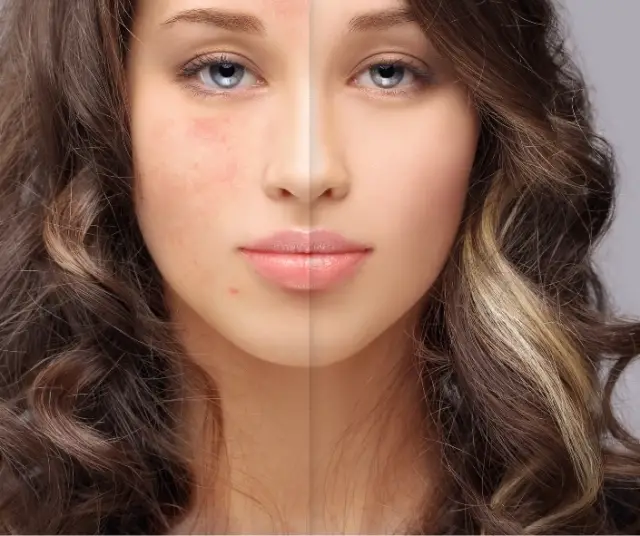Acne is a common skin condition that affects people of all ages. Although fighting acne is a challenge in itself, the blemishes and marks it leaves behind can be just as frustrating.
Why do Acne Spots Form?
Before tackling acne spot removal, it's important to understand why they form in the first place. When an acne breakout heals, the skin attempts to repair itself. In this process, excess melanin, the pigment that gives skin its color, is often produced. This may result in dark spots or redness in the affected area.
Acne spots can vary in color and type. Some are red and others brown, and their severity can range from mild spots to deeper scars. The good news is that, with proper treatment, many of these spots can disappear or be significantly reduced.
Strategies to Eliminate Acne Spots
1. Regular Skin Care
Regular skin care is the fundamental pillar to eliminate and prevent acne spots. Here's a more detailed breakdown of the key stages in your skincare routine:
Cleaning:
Proper cleansing is essential to remove excess oil, dirt, and dead skin cells that can clog pores and worsen acne. Use a mild soap-free cleanser to avoid irritating the skin. Cleanse your face twice a day, morning and night, to keep pores clear and reduce the chance of new breakouts.
Exfoliation:
Regular exfoliation can help remove dead skin cells, smooth texture, and improve the appearance of acne spots. Opt for a gentle exfoliant that doesn't cause abrasion and use it once or twice a week, depending on your skin type. Overexfoliation can be harmful, so be careful not to overdo it.
Hydration:
Hydration is essential to keep skin balanced and healthy. Although it may seem counterintuitive, even if you have oily skin, it is important to use a non-comedogenic moisturizer. These products are specifically designed not to clog pores and will help keep your skin barrier intact.
2. Daily Sunscreen
Sun protection is crucial to prevent the worsening of acne spots and the formation of new ones. Ultraviolet (UV) rays from the sun can trigger melanin production in the skin, which can make spots more visible. Use a broad-spectrum sunscreen with a sun protection factor (SPF) of at least 30 every day, even on cloudy days. Reapply as needed, especially if you sweat or get wet.
3. Products with Active Ingredients
Products containing active ingredients can be effective in addressing acne spots. These are some of the most common ingredients and their functions:
Glycolic Acid: Glycolic acid is a chemical exfoliant that helps remove dead skin cells and improves texture. It can also be effective in lightening stains.
Kojic Acid: Kojic acid is a depigmenting agent that can reduce the appearance of dark spots by inhibiting melanin production.
Niacinamide: Niacinamide, a form of vitamin B3, is an antioxidant that can help clear the skin and reduce inflammation, which is especially helpful for red acne spots.
Vitamin C: Vitamin C is another antioxidant that can brighten the skin and reduce pigmentation. It can also help stimulate collagen production, improving the overall appearance of the skin.
It is important to remember that incorporating products with active ingredients into your skin care routine should be done with caution. Start with low-concentration products and use sunscreen daily, as some of these ingredients can increase your skin's sensitivity to the sun.
4. Professional Treatments
If your acne spots are persistent or severe, you may want to consider professional treatments that can speed up the removal of these marks. Some options include:
Chemical Peel: Chemical peels are procedures that involve applying a chemical solution to the skin. This removes the top layers of the skin and can improve pigmentation and texture.
Microdermabrasion: Microdermabrasion is a non-invasive procedure that uses small crystals or a diamond tip to gently exfoliate the skin, improving its appearance.
Laser and Intense Pulsed Light (IPL): These treatments use light to target acne spots and can be effective in reducing pigmentation.
Steroid Injections: In cases of severe hyperpigmented spots, a dermatologist may recommend steroid injections to reduce inflammation and lighten the skin.
Professional treatments should be performed by experienced dermatologists or skin health professionals.
5. Time and Patience
Last but not least, it is essential to understand that removing acne spots takes time and patience. Don't expect instant results, as each person and each skin type is different. Consistency in your skincare routine and recommended treatments is key to seeing improvements over time. Patience is essential, as the skin needs time to heal and regenerate naturally.
Additional Tips
Here are some additional tips that can help you in your fight against acne spots:
- Avoid popping pimples: Squeezing or popping pimples can make spots worse and increase the risk of scarring.
- Non-comedogenic makeup : If you wear makeup, choose non-comedogenic products that won't clog pores.
- Diet and hydration: Maintain a balanced diet and drink enough water to keep your skin healthy from within.
- Consult a dermatologist: If you have concerns about persistent or severe acne spots, do not hesitate to consult a dermatologist. They can provide you with personalized guidance and treatment options specific to your skin.
